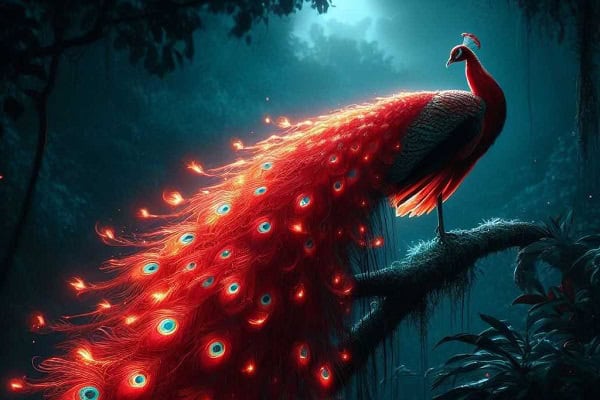Welcome to our exploration of the captivating world of red peacock. What you think are there red peacocks real or fake?
These stunning creatures have long fascinated both nature enthusiasts and fashion aficionados alike. But have you ever wondered if red peacocks are real or merely a product of imagination? We will delve into this intriguing question and shed light on the truth behind these vibrant birds.
Furthermore, we will touch upon the confusion surrounding red peacock cichlids and their resemblance to red peacocks. Are they one and the same, or are there distinct differences between the two? Join us on this journey as we dive into the ornate beauty of red peacocks and unravel the secrets that lie within their feathers.
Main Points:
- Red peacocks, admired for their vibrant appearance, have captivated the interest of both nature enthusiasts and fashion enthusiasts.
- There is a debate surrounding the authenticity of red peacocks, with some questioning whether they are real or fake.
- Red peacock cichlids often cause confusion due to their similar appearance to red peacocks, leading to the misconception that they are the same species.
- Exploring the vibrant feathers of red peacocks can reveal insight into their spiritual significance and cultural symbolism.
- Understanding the facts, habitat, care, breeding, and behaviour of red peacocks can provide valuable knowledge for those interested in these majestic birds.
Unveiling the Red Peacock
The red peacock is a truly captivating creature, with its vibrant colours and striking appearance. In this section, we will delve into the fascinating world of the red peacock, exploring its unique features and uncovering the spiritual meaning behind its existence.
Red Peacock Feather
One of the most remarkable aspects of the red peacock is its stunning feathers. These feathers are a true masterpiece of nature’s artistry, adorned with vibrant shades of red, blue, and green. The red peacock feather is a symbol of beauty, grace, and elegance.
The red peacock feather is a captivating sight, captivating the eyes with its brilliant colors and intricate patterns.
These exquisite feathers are not only admired for their aesthetic appeal but also hold significant cultural and spiritual meaning in various societies around the world.
The Spiritual Meaning of the Red Peacock
In many spiritual traditions, the red peacock is considered a symbol of transformation, renewal, and protection. Its vibrant colours are believed to represent positive energy, prosperity, and good luck.
- The red peacock is often associated with love, passion, and romance.
- It is believed to bring abundance and success into one’s life.
- Some cultures believe that red peacock feathers possess healing properties.
This spiritual symbolism makes the red peacock a cherished and revered creature, admired not only for its physical beauty but also for its deeper spiritual significance.
Related Post: Hummingbird Eggs: Facts and Care Guide
Fascinating Red Peacock Facts
Now that we’ve explored the enchanting world of the red peacock’s feathers and spiritual symbolism, let’s delve into some intriguing facts about these magnificent birds.
| Red Peacock Facts | Red Peacock Habitat |
|---|---|
| The red peacock (Afropavo congensis) is native to the forests of the Congo Basin in Central Africa. | The red peacock thrives in lush, tropical rainforests. |
| Male red peacocks are known for their vibrant plumage, while females have more subdued colours for better camouflage. | These birds prefer dense vegetation and can often be found near rivers and streams. |
| The red peacock’s diet mainly consists of fruits, seeds, insects, and small invertebrates. | They rely on their strong feet and beaks to forage for food in the forest undergrowth. |
These fascinating facts give us a deeper understanding of the red peacock’s natural habitat and behaviours, shedding light on how they have adapted to and thrived in their environment.
Red Peacock: Facts and Habitat
Red peacocks are truly remarkable creatures, known for their vibrant colours and captivating beauty. In this section, we will explore some fascinating facts about these magnificent birds, their natural habitat, and how to provide proper care to ensure their well-being.
Red Peacock Facts
Let’s start by diving into some intriguing red peacock facts:
- 1. Red peacocks, scientifically known as Pavo cristatus, are a subspecies of the Indian peafowl.
- 2. Unlike the common blue peafowl, the red peacocks displays stunning shades of copper, bronze, and gold in its plumage.
- 3. These remarkable colours are not the result of artificial processes but are naturally occurring genetic variations.
- 4. Red peacocks are believed to have originated in Sri Lanka and were selectively bred for their striking coloration.
- 5. Adult males, known as peacocks, have elaborate trains consisting of long, iridescent feathers, which they display during courtship rituals.
Red Peacock Habitat
The natural habitat of red peacocks plays a crucial role in their overall well-being. These birds thrive in lush, tropical woodlands and forested areas.
Here are some key characteristics of their habitat:
Red peacocks prefer habitats with dense vegetation, providing them with ample coverage and protection. They are often found in regions with a mix of open spaces and tree cover, allowing them to forage for food and flee from potential predators.
It is important to recreate a similar environment when housing red peacocks in captivity. Providing an aviary with plenty of foliage, perches, and hiding spots will ensure their comfort and reduce stress.
Red Peacock Care

To keep red peacocks healthy and happy, proper care and attention are essential. Here are some guidelines to follow:
- 1. Maintain a clean and spacious aviary with adequate space for these majestic birds to move around freely.
- 2. Provide a varied diet that includes a mix of high-quality commercial peafowl feed, grains, fruits, and vegetables.
- 3. Ensure access to clean water for drinking and bathing.
- 4. Monitor the temperature and humidity levels in the aviary to mimic their natural habitat.
- 5. Regularly check for signs of illness or injury and consult a veterinarian experienced in avian care if needed.
Red Peacock Diet
The diet of red peacocks consists of a combination of plant matter and insects found in their natural environment. In captivity, their diet can be supplemented with:
- 1. High-quality commercial peafowl feed: This provides essential nutrients and ensures a balanced diet.
- 2. Fresh fruits and vegetables: Offer a variety of options such as leafy greens, carrots, berries, and melons.
- 3. Grains and seeds: Include rice, oats, millet, and sunflower seeds as part of their diet.
- 4. Insects and protein-rich treats: Offer live insects like mealworms and crickets, as well as occasional treats like cooked eggs or small pieces of cooked chicken.
Remember to consult with a veterinarian or avian nutritionist to ensure that the diet meets the specific nutritional needs of red peacocks.
| Red Peacock Care Essentials | Peacock Diet |
|---|---|
| 1. clean and spacious aviary | 1. High-quality commercial peafowl feed |
| 2. Ample foliage and hiding spots | 2. Fresh fruits and vegetables |
| 3. Access to clean water | 3. Grains and seeds |
| 4. Monitoring temperature and humidity | 4. Insects and protein-rich treats |
| 5. Regular health checks |
By providing the right care, habitat, and diet, you can ensure the well-being and happiness of these incredible red peacocks.
Red Peacock Breeding and Behavior
When it comes to red peacocks, their breeding habits and mesmerizing array of colours are truly remarkable. Understanding their behaviour and lifespan is crucial for anyone interested in these captivating creatures.
Breeding
Red peacock breeding is an intricate process that showcases the beauty of nature. Males attract females through their vibrant colours and impressive courtship displays. These displays involve the male spreading his tail feathers, displaying a stunning array of reds, blues, and greens. This colourful spectacle mesmerizes the females and helps in the breeding selection process.
After mating, the female red peacock will lay eggs, typically in a secluded nest. The male does not contribute directly to incubation but plays a protective role, warding off potential predators and ensuring the safety of the nest and eggs. Incubation generally lasts around 27 to 30 days, after which the eggs hatch, revealing adorable peacock chicks.
Colors and Behavior
The striking red colouration of red peacocks is a result of selective breeding over generations. These vibrant hues make them highly sought-after, both in the wild and in captivity. The colour intensity and pattern may vary from bird to bird, adding to their individuality and charm.
Red peacocks are known for their confident and regal demeanour. They are active during the day, spending their time foraging for food and socializing with other birds. Their behaviour can be territorial, especially during the breeding season, when males defend their nesting areas from other males.
These majestic birds also possess a variety of vocalizations, including calls and displays, as a means of communication. These vocalizations vary depending on the situation, ranging from attracting mates to warning others of potential threats.
Lifespan
The lifespan of red peacocks can vary depending on various factors, such as genetics, diet, and overall care. On average, peacocks can live for approximately 15 to 20 years in the wild, while those in captivity may have a slightly longer lifespan due to favourable environmental conditions and proper care.
Ensuring a healthy and stress-free environment, a balanced diet, and regular veterinary check-ups can contribute to maximizing the lifespan of red peacocks in captivity.
Frequently Asked Questions
Q1: Red Peacock Real or Fake?
Red peacocks are not real. There are no records of red peacocks existing in nature. The red peacock feathers available online are usually dyed or bleached versions of natural blue or green peacock feathers.
Q2: Red Peacock Cichlid?
The Red Peacock Cichlid is a popular freshwater fish among aquarists, known for its bright red colouration and peaceful temperament. It’s native to Lake Malawi in East Africa and requires specific care in an aquarium setting.
Q3: The feather of a red peacock?
Red peacock feathers are not naturally occurring. Typically, the process involves dying or altering the colours of regular peacock feathers. Natural feathers are not red; instead, they are blue and green.
Q4: Red Peacock: Spiritual Meaning?
In spiritual symbolism, peacocks are associated with beauty, pride, renewal, and self-confidence. While there’s no specific mention of red peacocks in most spiritual texts, peacocks in general symbolize awakening, enlightenment, and immortality across various cultures.
Check Our Previous Articles
| Duck Hunting Season in Michigan |
| White Birds in Michigan |
| 21 Fascinating Facts About Crow |
| White Birds in Florida |
Final Thoughts on Red Peacocks Existence:
We have explored the captivating world of red peacocks and addressed the question of their authenticity: are red peacocks real or fake?
Through our investigation, we have uncovered fascinating insights into the vibrant display of red peacocks, their habitat, habits, and the confusion that arises with red peacock cichlids. While some may question the reality of their extraordinary beauty, we can confirm that they are indeed real.
Red peacocks, with their mesmerizing array of colours and majestic feathers, are a true marvel of nature. Their existence brings a touch of elegance and wonder to our world, making them highly sought-after in the world of decor and fashion.
Whether admired for their radiant plumage or cherished as spiritual symbols, red peacocks are a testament to the stunning diversity found in the natural world.
For more information about birds, Visit our website


Add comment